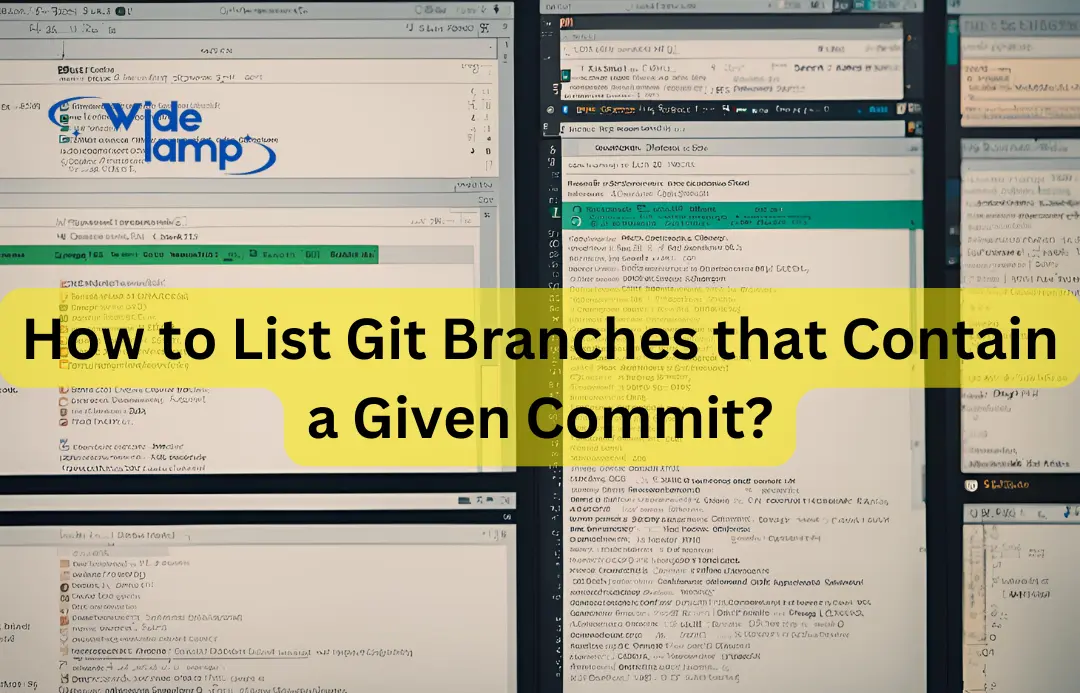|
Getting your Trinity Audio player ready...
|
How to List Git Branches that Contain a Given Commit?
In Git, branches are like separate lines of development where you can work on different features or fixes. Sometimes, you might want to know which branches contain a specific commit. This is useful when you’re working on a large project with many branches and need to trace where a particular change has been applied.
This article will explain how to list all the branches that contain a specific commit using Git. We’ll also go through an example to make things clearer.
Read More: History of computers
Read More: What is Artificial Intelligence (AI)?
What is a Commit?
First, let’s quickly go over what a commit is. A commit is a snapshot of your project at a specific point in time. Every commit in Git has a unique identifier, known as a SHA hash, which looks something like this: abc1234efg5678. This hash helps you track changes and identify commits across your project.
Why Would You Want to List Branches with a Specific Commit?
Sometimes, you might want to know for list branches with specific commits:
- Which branches have a bug fix that was made in a specific commit?
- Whether a new feature (represented by a commit) has been merged into multiple branches.
- If a commit is made to the production branch or other important branches,
By listing the branches that contain a specific commit, you can better manage your code and track changes across the project.
Command to List Branches that Contain a Commit
To list all branches that contain a specific commit, you can use the following command in Git:
bashCopy codegit branch --contains <commit-hash>
Here’s how it works:
git branchis the command to list branches.--containsis an option that restricts the list to branches that contain the given commit.<commit-hash>is where you would put the SHA hash of the commit you’re searching for.
Example
Let’s walk through an example.
Step 1: Find the Commit Hash
Suppose you’re working on a project and you want to see which branches contain a commit with the message “Fixed login bug.” You can find the commit hash by using:
bashCopy codegit log
This command will show a list of commits. Let’s assume the commit hash for “Fixed login bug” is 123abc4.
Step 2: List Branches with the Commit
Now that you have the commit hash (123abc4), you can use the following command to list all the branches that contain this commit:
bashCopy codegit branch --contains 123abc4
Output
The command might return something like this:
bashCopy code* main
feature/login-fix
production
This means the commit 123abc4 (the one that fixed the login bug) is present in the following branches:
main: the main development branch.feature/login-fix: a branch where the bug fix was initially made.production: the branch used for the production environment.
More About the Command
The git branch --contains command helps you pinpoint where specific changes exist in your project. Here are a few more tips to help you understand the command better:
- If you run the command without specifying a commit hash, Git will list the branches that contain the commit you’re currently on.
- You can combine this command with other options, like
-rto include remote branches, or-ato list both local and remote branches.
For example, to list both local and remote branches containing the commit 123abc4, you can use:
bashCopy codegit branch -a --contains 123abc4
Summary
In summary, you can use the git branch --contains <commit-hash> command to list all branches that contain a specific commit. This is very useful for tracking where changes have been applied to your project. By learning to use this command, you’ll have better control over managing your Git branches and commits.
Key Points:
- A commit is a snapshot of your project at a specific time, identified by a unique SHA hash.
- The
git branch --containscommand lists all branches containing a specific commit. - This command is helpful when you want to check if a bug fix or new feature has been applied to multiple branches.
Understanding this Git feature will help you stay organized, especially in large projects where many branches are being used simultaneously.

Q & A – Section
Questions that are very helpful for everyone and clear some doubts…
-
What is a commit in Git?
A commit in Git is like a snapshot of your project at a specific point in time. Each commit has a unique identifier called a SHA hash, which helps you keep track of changes in your project.
-
Why might you want to list branches that contain a specific commit?
You might want to list branches with a specific commit to see where important changes (like bug fixes or new features) have been applied. It’s beneficial in big projects with many branches.
-
What is the Git command to list branches that contain a given commit?
The command is
git branch --contains <commit-hash>. You replace<commit-hash>with the unique identifier (SHA hash) of the commit you’re searching for. -
How do you find the commit hash?
You can find the commit hash by using the command, which shows a list of all commits with their messages and unique SHA hashes.
-
Can you give an example of using the
git branch --containscommand?Sure! If you found the commit hash “123abc4” for a bug fix, you would run
git branch --contains 123abc4. This would list all the branches where that bug fix is applied. -
What might the output of the
git branch --containscommand look like?The output might show something like this:
* main feature/login-fix production
This means the commit is present in the “main”, “feature/login-fix”, and “production” branches. -
How can you list both local and remote branches that contain a commit?
To list both local and remote branches, you can use the command
git branch -a --contains <commit-hash>. The-aoption includes all branches.




